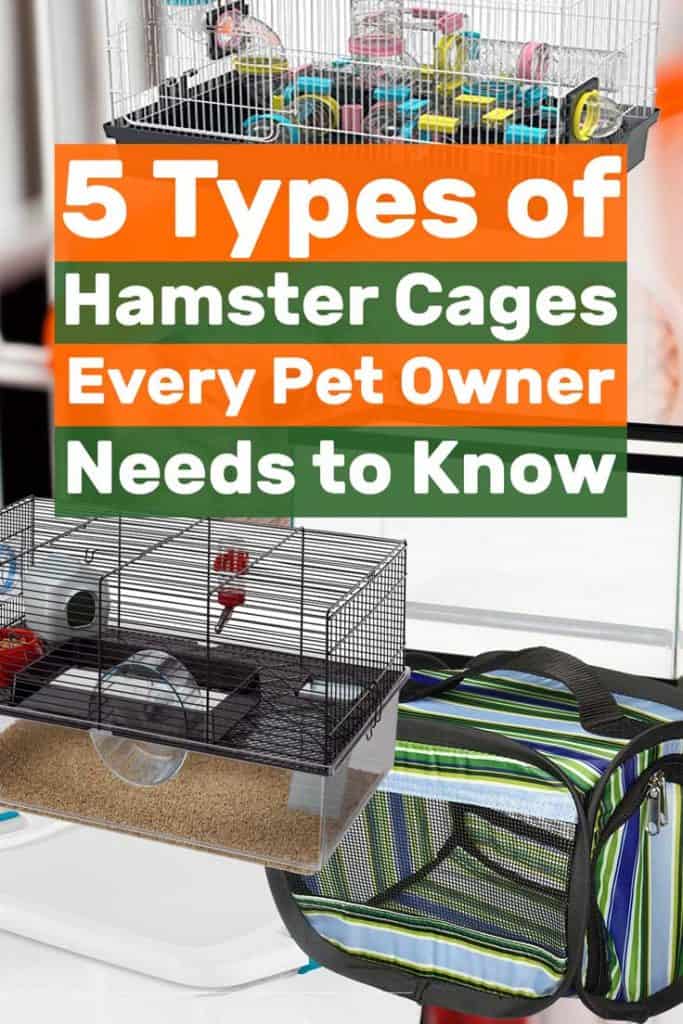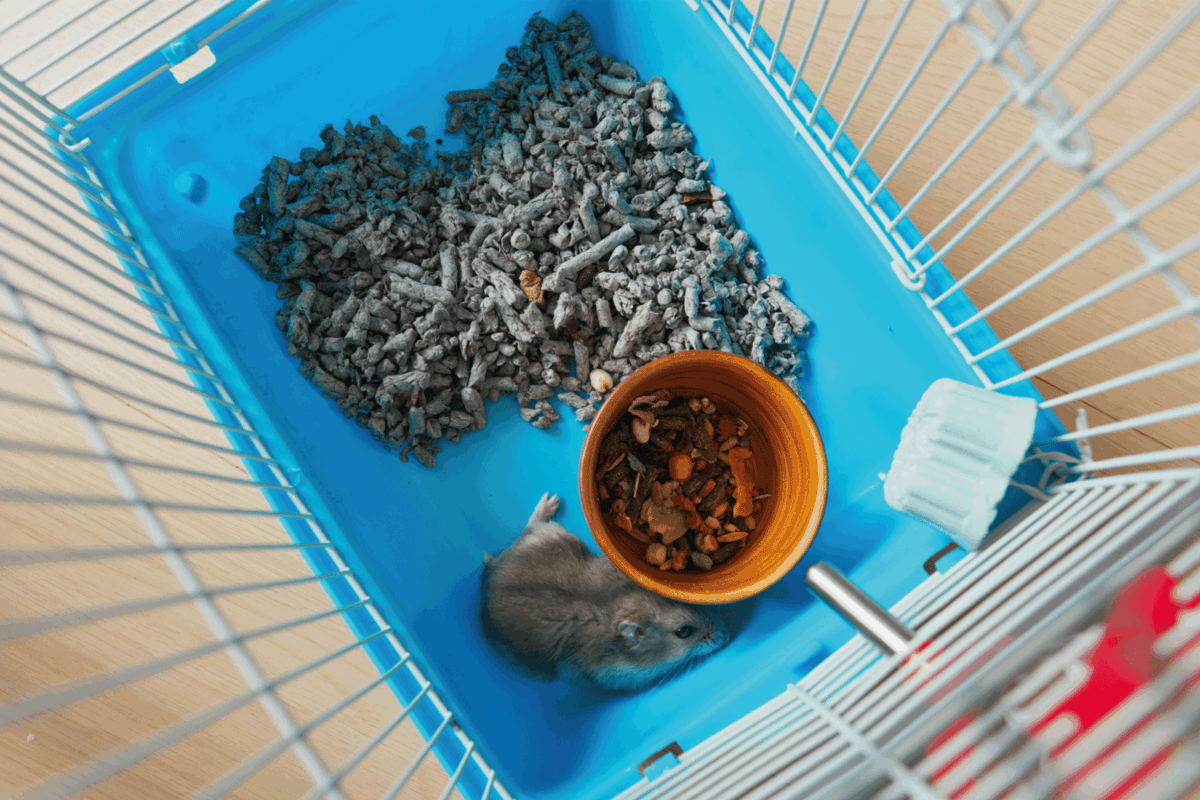Your hamster spends a lot of time in its cage, but which type is best-suited to them and their needs? We did extensive research to provide you with the answer.
 The types of hamster cages are:
The types of hamster cages are:
- Wire Cages
- Glass Tanks
- Homemade plastic tanks
- Travel cages
- Cage systems with connecting tunnels
Some of these cages are the basic, everyday ones you’d see at any pet store while others are more complex. You probably have questions about each cage type, which is why we encourage you to read on. We’ll elaborate on the five types of cages presented above as well as provide some pictures and shopping links.
1. Wire Cages
The first type of cage is one of the simplest: a wire enclosure.
The base of this cage is typically made of plastic or another durable material. The walls and ceiling consist of thick wire that is often covered with a protective top coat. Wire cages can be single-level or multi-level depending on your hammy’s needs and your budget.
Pros of Wire Cages
- Wire cages are one of the most inexpensive cages you’ll come across. They’re also widely available. You should have no difficulty finding one.
- Cleaning the plastic base of the cage is quite easy; sometimes this base is even removable.
- The open bars of the wire cage provide adequate ventilation. That means even if your hammy makes a mess, the smell shouldn’t hit you hard right away. (Still, clean their cage regularly!)
- If your hamster is a climbing type, the bars of this cage provide a lot more entertainment compared to other cage types.
Cons of Wire Cages
- Cleaning each rung of the metal cage can be kind of annoying, even if it is necessary.
- Your hamster could start chewing the metal bars, which can cause oral health issues with time.
- Depending on the width of the metal bars, it’s possible for some hamsters to slip through and escape.
- The plastic tray may lack the depth a hamster requires for burrowing.
- Sometimes these cages are just too small for a growing hamster.
Read more: How to Stop My Hamster From Chewing the Bars of the Cage?
Examples of Wire Cages for Hamsters
In this first image on Instagram, one or two lucky hamsters (not pictured) will be able to enjoy life in a double-decker wire cage. Make sure you have a ladder, stairs, or another means for the hamsters to get from one story to another.
Here’s another example of a wire hamster cage -

As you can see with this one, there’s a decent width between the bars. While the adorable hamster in the picture likely can’t fit through, smaller and slimmer hammies might try. You’ll have to keep a close eye on your pet and curb their explorative side.
Where to Buy Wire Cages
If you’re looking to get your hamster a wire cage, try these Amazon products.
Ferplast Hamster Cage

Measuring a generous 23.6 x 14.4 x 11.8 inches, the double-decker Ferplast wire cage is a smart choice for bigger hamsters. If you have more than one hammy, this is also a cage you’d want to consider.
The base is made of translucent plastic with wire netting for the top portion. Since you can see right into the bottom half, you can always check in on your hamster, even when they don’t necessarily think you can see them.
Prevue Pets Universal Small Animal Home

For smaller hammies, the Prevue wire cage fits the bill. The bars have a width of 3/8 inches each, so there’s no risk of even young hamsters escaping. This enclosure is 17 ½ inches high, 19 inches wide, and 32 ½ inches long.
There are two doors for entry, which makes cleaning your hamster’s messes a breeze. The black plastic base, while not transparent, is plenty deep. Your hamster should be able to burrow happily anytime.
GalaPet Hamster Cage

Our last pick for wire cages is from GalaPet. This darling enclosure in cheery bright-blue measures 17.3 x 12.6 x 13.8. There are wooden play accessories included that will challenge your hamster for hours.
Other cool stuff that comes with this cage includes a chew string, water bottle, ladder, wooden swing, and a cozy house on a wooden platform.
2. Glass Tanks as Hamster Cages
The next type of enclosure you might be interested in for your hamster is a glass tank. These tanks will often be plenty sizeable and deep so hammy has room to run, play, and burrow. To keep hammy in the tank, a lid made of mesh or wire is typically included.
You might be worried that there's not enough air circulation in the glass tank. You may have heard guinea pigs and pet rats should not be kept in one because there's not enough air circulation. And that's true. Hamsters are different though.
Because they are desert animals, hamsters don't excrete as much urine as other pet rodents. Pet rats, guinea pigs, and other small pets simply urinate more, creating more toxic fumes. You have to keep them in a well-ventilated wire cage, or they'll end up suffocating from these urine products.
Hamsters, on the other hands, are perfectly suited for living in a glass tank. They don't produce as much urine, and as long as you clean the cage in the right intervals, they have no problem spending their days in a large glass tank.
Pros of glass tanks for hamsters
- Glass tanks are completely transparent, so you can always watch your hammy. These tanks are especially nice to have at schools, where children can have a classroom hamster and observe its behavior.
- There are no bars for your hamster to injure themselves climbing or chewing on.
- You can always tell when the tank is getting dirty so you never go too long between cleanings.
- As long as you keep the top covered with a wire net, your hammy gets plenty of fresh air and great ventilation.
Cons of glass tanks for hamsters
- These tanks are the most expensive option. A large terrarium can cost hundreds of dollars.
- There’s nothing for your hamster to climb on, so you’ll have to provide them with plenty of activities and exercise to keep them entertained.
- Glass can get smudgy and has to be cleaned often.
Examples of Glass Tanks
test_111
This Instagram user gave their hammies the good life, lining up a glass cage and a homemade plastic one side by side. All of the tanks are large and filled with interesting toys and exercise options.
Here’s another great glass tank example. You can see how one of these tanks gives small and mid-sized hamsters plenty of space to explore. With enough hidey-holes, toys, activities, and burrowing spots a hamster in a glass tank never needs to get bored.
Remember to introduce new ones occasionally, including good hamster chew toys that your hammy can work through.
Where to Buy Glass Tanks
If you’re interested in getting your hamster a glass tank, here’s a great pick from Amazon.
Aqueon Aquarium

Even though this a fish tank, the Aqueon aquarium can also double as a glass tank for hamsters. Its measurements are 20 ¼ x 10 ½ x 12 9/16, so there’s plenty of room for your hammy here. The silicone seals and black plastic trim add durability to the tank. Since it’s made for fish, you’d have to get a wire top separately.
3. Homemade Plastic Bins as Hamster Cages
Do you have a plastic storage bucket handy? If so, you can configure it into a cage for your hamster. And if you don't have one handy, you can always buy one. They're fairly cheap, allowing you to create a supersized enclosure at a great price if you have some basic DIY skills.
Since you can't have plastic that's as transparent as glass, these tanks usually have some kind of wire-covered "window" on one side. You will also need to create a lid from chicken wire or another type of sturdy mesh.
Pros of plastic tanks for hamsters
- This is by far one of the cheapest hamster cage ideas. You’d only have to spend money on modifying the buckets.
- Plastic is easy to wipe down, which saves you time when you clean out hammy’s enclosure.
- These tanks are very versatile. You can stack two tanks of varying sizes on top of each other or line ‘em up side by side. If you’re feeling especially creative, you can even cut holes in several buckets, connect them with play tubes, and then make an intricate playground for your hammy.
Cons of plastic tanks for hamsters
- You must make sure there are no sharp or pointy plastic edges in or around the enclosure. Otherwise, your hamster could chew or rub on them, injuring themselves.
- Sometimes it takes repeated washings to fully rid plastic of odors. If the odors we’re talking about are hamster feces or urine, living with that smell can be especially unpleasant.
Examples of Homemade Plastic Tanks
Here’s a wire hamster cage and a homemade plastic one together. Remember, the only way to keep two hamsters is by providing each animal with his/her own separate enclosure. Unless you have two dwarf hamsters that have been cohabiting since they were pups, don't try to make hamsters share a cage.
Read here more about why each hamster needs to have its own cage.
If you want to get colorful with a homemade plastic tank, this image is a great inspiration. Just look at all this pink! The hamster certainly seems to love it.
How to Make a Homemade Plastic Bin Hamster Cage
If you want to make one of these plastic bins for your own hammy, you absolutely can. It's a fantastic DIY project if you're handy and have the right tools. Here's a great video showing you how to create a top-notch hamster cage from a plastic tank -
Need more help? We have a more detailed post about creating a DIY hamster cage right here.
4. Travel Cages
Your hamster might not be a jetsetter, but sooner or later, they’re going to have to leave the house. This is where a travel cage comes in handy. These cages are small and secure so your hamster can’t get loose when you try to take them to the vet. Because they are small, travel cages are also not intended for long-term use.
Pros of travel cages
- Easier than moving your entire hamster cage when you need to go to the vet.
- Most travel cages are made of wire so you can see what your hamster is doing at all times.
- The secure latching door of these cages gives you confidence that your hamster will stay mostly put while traveling.
- A carrying handle that’s metal or plastic makes bringing your hamster to the vet or anywhere else easy.
Cons of travel cages
- Some of these cages might be too small for a fully-grown larger hamster breed. You’ll have to shop around carefully.
- Never place your hamster in a travel cage for more than a few hours. Even the best travel cage is too small for much longer.
Examples of Travel Cages
In this image, you get a great idea of what a travel cage looks like. This one is made entirely of plastic. There’s even a secure latch and convenient thick carrying handle.
A more stylish option for a travel cage here. Again, small and only adequate for a short trip.
Where to Buy Travel Cages
There are many more travel cages out there, including softer canvas ones for long trips. Here’s a couple of our favorite picks, all of which are available on Amazon.
Ware Manufacturing Twist-N-Go Carrier

This highly-rated canvas Twist-N-Go Carrier from Ware Manufacturing lets hammy travel in style. You can get this carrier in small, medium, and large sizes.
The small size has a height of seven inches, a depth of 9.5 inches, and a width of seven inches. The biggest carrier is 10.5 inches high, 14.25 inches deep, and 10.75 inches wide.
All sizes include a scratch-proof screen. The carrier itself is made of a nylon canvas with zippers that close fully so hammy can’t go anywhere. There are several colors available.
Another soft travel bag is DETOP’s pet carrier. This too comes in three sizes: small, large, and XL. The smallest one has a depth of 2.4 inches, a width of 4.7 inches, and a length of 6.3 inches. If you get the XL, it’s 2.95 inches deep, 7.9 inches wide, and 9.9 inches long.
The carrier bag features velvet lining inside, spongy material on top of that, and an outer layer made of velvet and plastic mesh. You even get a shoulder strap for carrying and keeping a hammy close on all your adventures.
See more: The 10 Best Hamster Travel Cages
5. Cage Systems with Connecting Tunnels
The last type of hamster cage is the most ornate. This is a cage system with connecting tunnels. The level of customization is completely determined by your budget, available space, and creativity. You could have just a few connecting tunnels or dozens. The sky’s the limit!
Pros of cage systems for hamsters
- As your hamster travels from one tunnel to another, they’re getting plenty of exercise.
- This is such a fun setup that your hamster will never get bored.
- Connecting tunnels work with all sorts of cages, including wire and plastic enclosures.
- This cage system just looks cool.
Cons of cage systems for hamsters
- Older hamsters could become exhausted by all the effort of getting from Point A to Point B.
- It can be expensive to add this much to your hamster cage.
- You need to have a lot of room to dedicate to such a complex, ornate cage system.
- Cleaning all the tunnels can be a pain.
Examples of Cage Systems with Connecting Tunnels
This hamster doesn’t necessarily have a ton of connecting tunnels in their enclosure. Still, there's a lot here to love with this fun cage setup!
This hammy is certainly living the life. Look how thrilled it is to be exploring its huge habitat. Translucent plastic tubes like those featured in this image make for a great photo opp, too.
Where to Buy Cage Systems with Connecting Tunnels
Want to get your hamster into the tunneling life? You can start with one or more of these cage systems -
GNB PET Super Large Cage Habitat with Complete Tunnel Module

This wire cage from GNB PET has a tall tunnel system your hamster will love. The tunnels are made of see-through plastic with pastel rings throughout. The cage includes a plastic base that can be taken out when cleaning time rolls around.
You can then add more tunnels, leading to additional cage units, or just creating complex mazes for your hamster to explore. Read our complete guide about hamster tunnels for more ideas and inspiration.

In Summary
There are five types of hamster cages: wire, glass, plastic, travel, and cages with connective tunnels. No matter your budget or how much room you have to spare, you can put your hamster in a pretty nice home in one of these cages. Good luck!
Already a hamster owner? Leave us a comment to let us know which type of cage you have and what you like and dislike about it.
Listed above are the types of hamster cages but choosing the perfect one is a bit of a challenge, check out How To Choose The Best Cage For Your Hamster. This post is already laid out for you so all you need to do is check it out!





I just got two dwarf hamsters. Regarding the part about each hamster needing their own cage, is it acceptable to have two cages connected by tunnels, or do the cages have to be separated?
I know this comment was a while ago. You can keep them together just be extra cautious if you spot any signs of aggression. And then separate them.
i mean..it is ok,as long as they dont fight eachother.
I dont really reccomend wired cages..a hamster bar chewing in a wired cage is a sign of stress.And do remember that small enclosures for hamsters can cause them really stressed as hamsters are adventurous.tho the travel cages are very reccomended WHEN you are gonna travel somewhere,not making them live there forever.ex. bin cages,small bin cages are good for traveling.but dont make them live in there forever.use bigger bin cages like 78liter bin cages.The cons of using small cges makes a hamster more likely to get a shorter life span becuzz they are stressed.soooo yes